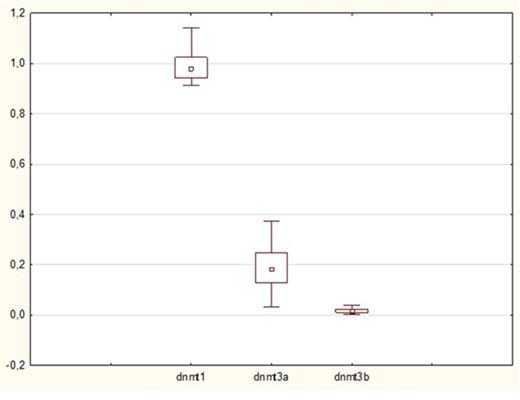Abstract
Background and aims: Presently, there is growing evidence that along with the important role of genetic abnormalities, epigenetic aberrations are relevant factors in multiple myeloma (MM). As was recently found, genome-wide analysis of DNA methylation reveals epigenetic alterations in plasma cells from patients with MM and individuals with monoclonal gammopathy of undetermined significance (MGUS). MGUS is characterized by predominant hypomethylation. Transformation into MM is accompanied by progressive hypermethylation with maximum methylation seen in relapsed disease. DNA methyltransferases (DNMTs) catalyze DNA methylation through transfer of methyl group to cytosine of the CpG dinucleotides, resulting in 5-methylcytostine. DNMT1 maintains patterns of methylated cytosine residues in human genome. DNMT3A and DNMT3B are de novo DNA methyltransferases, whose role is to maintain new methylation pattern that forms due to formation of the cancer.
Methods: 30 bone-marrow aspirates from individuals with MGUS or MM patients before the treatment initiation were used. The cDNA was synthesized using 100 ng of total RNA in a 20 µl reaction volume (Roche, Diagnostics, Basel, Switzerland). Quantification of DNMT1, DNMT3a and DNMT3b levels by TaqMan® probes (Life Technologies, Grand Island, NY) with Xceed qPCR Master Mix (IAB, BioTech-Europe, Czech Republic) was performed. For normalization, the GAPDH was used.
Results: Although MM is characterized by widespread alterations in DNA methylation, we observed that DNMT3a and DNMT3b de novo methyltransferases were underexpressed in both, MGUS individuals and MM patients when compared to DNMT1 expression level (Figure 1). The transcribed genes have increased levels of 5-hydroxymethylcytosine, then the DNMTs activities might compensate for active hydroxymethylation - demethylation.
Conclusions: Our results confirm that the expression of de novo DNA methyltransferases is deregulated in MM cell lines. The presented analysis is first of its kind that was performed on human myeloma cell lines, especially with the focus on the residual expression of Dnmt3a.
With support of the grant NT14393.
Quantitative RT-PCR for DNMT1, DNMT3a and DNMT3b in MGUS individuals and MM patients.
Quantitative RT-PCR for DNMT1, DNMT3a and DNMT3b in MGUS individuals and MM patients.
No relevant conflicts of interest to declare.
Author notes
Asterisk with author names denotes non-ASH members.


This feature is available to Subscribers Only
Sign In or Create an Account Close Modal